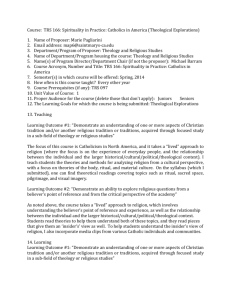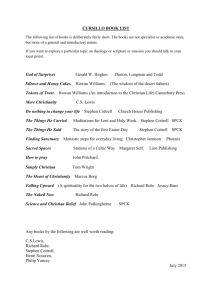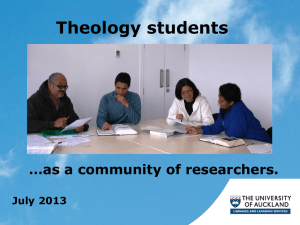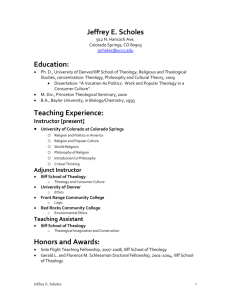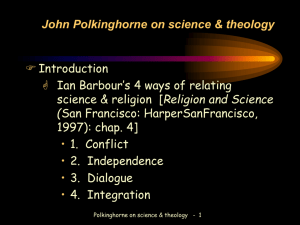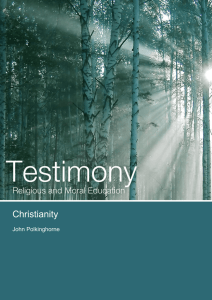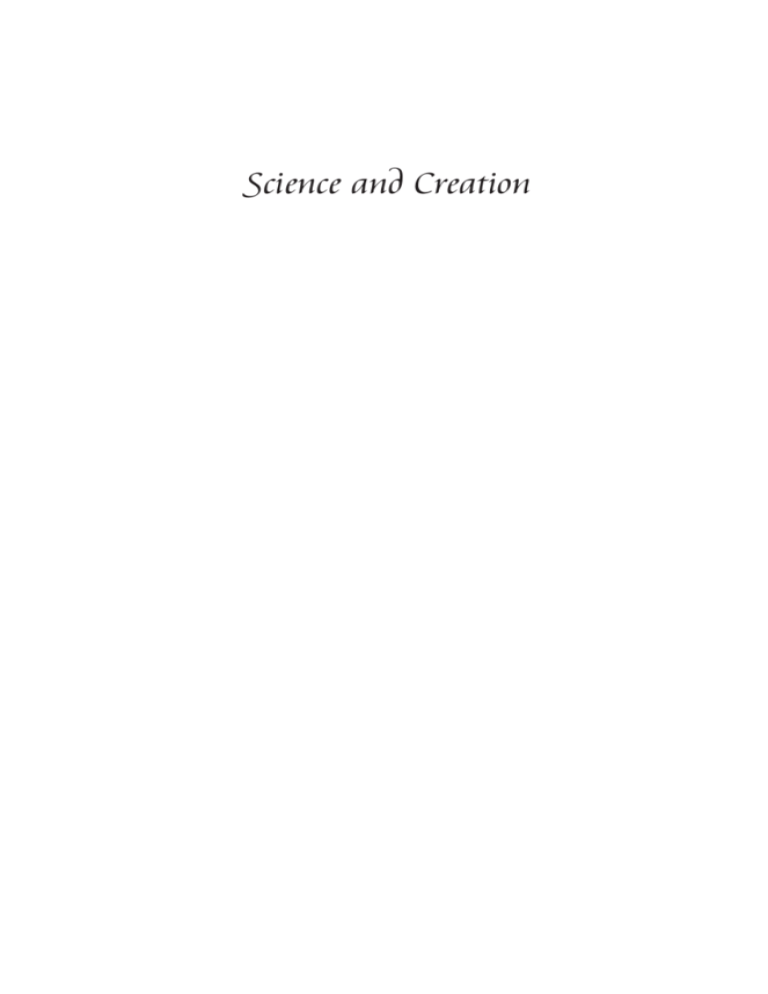
Science and Creation
John C. Polkinghorne
Science and Creation
the search for understanding
Templeton Foundation Press
Philadelphia and London
Templeton Foundation Press
300 Conshohocken State Road, Suite 670
West Conshohocken, PA 19428
www.templetonpress.org
2006 Templeton Foundation Press Edition
Originally published by SPCK, 1988
© 1988 by John Polkinghorne
Preface © 2006 by John Polkinghorne
All rights reserved. No part of this book may be used or reproduced,
stored in a retrieval system, or transmitted in any form or by any means,
electronic, mechanical, photocopying, recording, or otherwise, without
the written permission of Templeton Foundation Press.
Designed and typeset by Kachergis Book Design
Templeton Foundation Press helps intellectual leaders and others learn
about science research on aspects of realities, invisible and intangible. Spiritual
realities include unlimited love, accelerating creativity, worship, and the benefits
of purpose in persons and in the cosmos.
The Scripture quotations in this publication are from the Revised Standard
Version of the Bible, copyrighted 1946, 1952, © 1971, 1973 by the Division of Christian Education of the National Council of the Churches of Christ in the U.S.A.,
and are used by permission.
library of congress cataloging-in-publication data
Polkinghorne, J. C., 1930–
Science and creation : the search for understanding / John
Polkinghorne.
p. cm.
Originally published: London : SPCK, 1988.
Includes bibliographical references and index.
ISBN-13: 978-1-59947-100-6 (pbk. : alk. paper)
ISBN-10: 1-59947-100-0 (pbk. : alk. paper)
1. Religion and science. 2. Creation. I. Title.
BL240.3.P57 2006
261.5ʹ5­­—dc22
2006003014
Printed in the United States of America
06 07 08 09 10 11
10 9 8 7 6 5 4 3 2 1
To the places of my Cambridge education
The Perse School, Trinity College, Westcott House
and to my teachers.
.......the very order, changes, and movements in the universe,
the very beauty of form in all that is visible, proclaim, however
silently, both that the world was created and also that its Creator
could be none other than God whose greatness and beauty are
both ineffable and invisible.
—St. Augustine, The City of God
Contents
Preface to the 2006 Edition ix
Acknowledgments xv
Introduction 3
1. Natural Theology 7
2. Insightful Inquiry 25 3. Order and Disorder 44
4. Creation and Creator
63 5. The Nature of Reality 83
6. Theological Science 101
Notes 119
Bibliography 129
Index 133
Preface to the 2006 Edition
Two topics are natural “frontier issues” in exchanges between science
and religion. One is natural theology, the search for knowledge of God
derived from general experience, based on the inspection of the world
and the exercise of reason. The other topic is the doctrine of creation,
religion’s claim that there is a divine mind behind the order that science discovers in nature, and a divine purpose behind unfolding cosmic history. In a variety of forms, these issues have long been on the
agenda for the dialogue between science and religion, providing central topics for the interaction between these two great human quests
for truth and understanding. I wrote Science and Creation to make a
contribution to this conversation, and the first two-thirds of the book
concentrates on these two themes.
Natural theology languished for about a century after the publication of Charles Darwin’s On the Origin of Species, for that book had
undermined a simple theological appeal to design in nature by showing that the origin of the functional aptness of living beings did not
need to be explained by invoking the direct intervention of a divine
designer. However, the second half of the twentieth-century saw a revival of natural theology in a new and significantly revised form. It
was no longer presented as a kind of rival to science, claiming to give
an alternative explanation of biological structures, but it sought instead to complement science by setting the latter’s insights in a more
profound context of understanding. The deep intelligibility of the universe (a fact that makes science possible) and the rationally beautiful
order discerned by fundamental physics (which rewards investigators
ix
P r e fa c e t o t h e 2 0 0 6 e d i t i o n
with the experience of wonder) are features of the world too significant to be treated simply as happy accidents. Yet science itself is too
narrow in its explanatory scope to be able to offer understanding of
these experiences. Though they arise from the pursuit of science, their
source lies beyond its self-limited intellectual horizon. The new natural theology affords a deeper insight when it affirms that the rational
transparency and rational beauty of the universe are signs of the presence of the mind of that world’s Creator. Christian theology understands humanity’s scientific abilities to be an aspect of the gift of the
imago dei, the image of God.
Chapters 1 and 2 discuss these ideas. There are two issues referred
to which have seen significant development subsequent to the original
publication of the book. One is the connection between natural theology and the Hebrew wisdom literature (Deane-Drummond 2000). The
other is the continuing analysis of arguments relating to the insights
of the anthropic principle (for a recent account, see Holder 2004). An
issue that was not on the agenda in 1988, but which has received a lot
of attention in recent years, is the approach to issues of natural theology made by the proponents of the so-called Intelligent Design (ID)
movement. It is claimed that at the molecular level there are biological
systems that are irreducibly complex (Behe 1996), that is, they consist
of a number of component parts, all of which have to be in place before the system becomes effective. Entities of this kind could not have
evolved gradually through the Darwinian process of the accumulation
of small differences, each of which is supposed to confer some additional functional advantage step by step. It is suggested, therefore, that
these irreducibly complex systems are signs of the work of some form
of designing intelligence (not explicitly identified with God in the ID
literature, but that is surely the tacit underlying assumption). Adherents of ID have been criticized for disguising a theological agenda under the cloak of quasi-scientific claims. I think this criticism is unfair,
since the existence of irreducible complexity is surely a scientific issue,
P r e fa c e t o t h e 2 0 0 6 e d i t i o n xi
and, indeed, its establishment would be a major scientific discovery. I
do not think, however, that that discovery has actually been made. The
analyses offered do not seem to take adequate account of the subtlety
and improvisatory character of evolutionary process, in which properties developed for one purpose can be co-opted to serve as part of the
response to a different set of challenges to life. Moreover, I believe that
the tacit theological motivation that seems to lie beneath the ID program is mistaken. The God who is the ordainer and sustainer of nature acts as much through natural processes as in any other way, and
it is an error to look for signs of the Creator’s activity only in apparent
breaks in the continuity of creative process.
The discussion of creation in chapters 3 and 4 emphasizes two
insights, one scientific and the other theological, which have a relation of complementary consonance with each other. The discussion
of chapter 3 shows how the fruitful process of the world involves at
all stages of its history an interplay between “chance” (understood as
happenstance, the particular historical contingency that this happens
rather than that) and “necessity” (the regular order of the universe).
Another way of making the same point is to recognize that situations
in which true novelty emerges are always “at the edge of chaos,” regimes in which order and disorder interlace without destroying each
other. Chapter 4 then interprets the resulting openness of cosmic process, leading to the unforeseeable emergence of new possibilities (such
as life and consciousness), as signs of the fertility and freedom bestowed by the Creator upon creation, a world whose history has more
the character of a grand improvisation than that of the performance
of an already-written score. This insight corresponds to an important
theological realization, very widely acknowledged in the second half
of the twentieth century, that creation is an act of divine kenosis, an
expression of the self-limitation exercised by love, through which the
Creator allows creatures to be themselves and to make themselves (see
the essays in Polkinghorne 2001).
xii
P r e fa c e t o t h e 2 0 0 6 e d i t i o n
The discussion of these two chapters involved a very preliminary
consideration of a topic taken up again in my next book (Polkinghorne
1989) and exhaustively discussed in the science and religion community in the 1990s, namely, the issue of divine action. Here I simply want
to note that I have changed my mind on one point. I no longer want
to insist that God never acts as a cause among causes. I have come to
believe that God may choose to act as a providential cause within the
open grain of nature, and I see the gracious decision to act in this way
as being part of the divine kenosis involved in creation (Polkinghorne
2001, 104–5).
Chapter 5 is the beginning of a process of attempting to find some
way of metaphysical thinking that does not deny the integrity of creation or the psychosomatic unity of human beings, and that treats with
equal weight what appear to me to be our undeniable experiences of
the reality of both the physical and the mental. The quest for a dualaspect monism of this kind seems to be of the greatest importance, and
I have subsequently continued to wrestle with the difficulties of the
task (Polkinghorne 2000, 95–99). In our present state of understanding, I do not think that we can expect an early resolution of all perplexity. Perhaps we can take to heart a lesson exemplified many times
in science, that a current lack of a fully adequate explanatory theory is
no ground for the denial of the reality of experienced phenomena, nor
for discouragement from the task of preliminary attempts at conceptual exploration.
Chapter 6 affirms two basic convictions that undergird much
of my thinking: a belief in the ultimate unity of knowledge, and a
commitment to seek truth through the search for well-motivated
belief. I subsequently came to call the latter approach, with its strategy of moving from experience to understanding, “bottom-up thinking.” My Gifford Lectures (Polkinghorne 1994) represent my most sustained effort to approach theology in this fashion.
When I wrote this text in the 1980s, I followed what was then the
P r e fa c e t o t h e 2 0 0 6 e d i t i o n xiii
majority convention of using a male pronoun for God and speaking
of humanity as mankind. Of course, I was never so foolish as to think
that God was actually male, or that all scientists were men. Since then
I have become conscious and have recognized that this former mode
of discourse is inappropriate. I ask the pardon of contemporary readers for the errors of my youth.
john polkinghorne
Queens’ College, Cambridge
December 2005
Additional Bibliography
Behe, M. Darwin’s Black Box. New York: The Free Press, 1996.
Deane-Drummond, C. Creation Through Wisdom. Edinburgh: T & T Clark,
2000.
Holder, R. D. God, The Multiverse and Everything. Aldershot, UK: Ashgate,
2004.
Polkinghorne, J. C. Science and Providence. London: SPCK, 1989; Philadelphia:
Templeton Foundation Press, 2005.
———. Science and Christian Belief. London: SPCK, 1994; also published as The
Faith of a Physicist. Minneapolis: Fortress, 1996.
———. Faith, Science and Understanding. London: SPCK and New Haven: Yale
University Press, 2000.
Polkinghorne, J. C., ed. The Work of Love. London: SPCK and Grand Rapids,
MI: Eerdmans, 2001.



